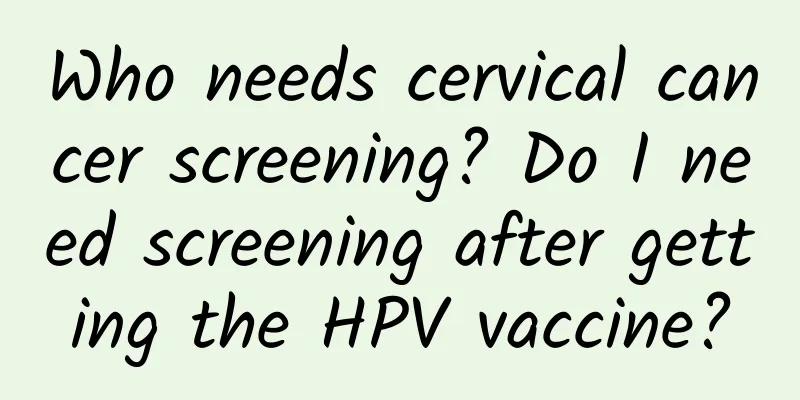Who needs cervical cancer screening? Do I need screening after getting the HPV vaccine?

|
First, let's learn about cervical cancer. In the female pelvic structure, the bladder is in front and the rectum is in the back. The uterus is between the bladder and the rectum, located in the middle of the pelvic cavity. The uterus is inverted pear-shaped, and the cervix is the gateway to the uterus, located at the lower end of the uterus. Malignant tumors that occur in the cervical epithelium are cervical cancer. Cervical cancer is one of the most common malignant tumors in women, with more than 500,000 new cases worldwide each year, and nearly half of the cases result in death. Despite the seriousness of the disease, it is currently the only cancer with a clear cause and the only one that can be completely prevented and treated through vaccination, screening, early detection, and thorough prevention. The two most important things to prevent cervical cancer are screening and vaccination. Among them, screening is the top priority, and even women who have been vaccinated should have regular checkups according to their own conditions. 1. Why do we need cervical cancer screening? Through early screening, early diagnosis and early treatment, cervical precancerous lesions can be diagnosed and treated in a timely manner, reducing the incidence of cervical cancer. At the same time, cervical cancer can be diagnosed at an earlier stage, which improves the cure rate and survival rate of cervical cancer. For women of childbearing age who wish to have children, improving cervical cancer screening will help detect cervical diseases early before pregnancy, allowing for early treatment intervention and avoiding symptoms such as abnormal vaginal bleeding after pregnancy. Currently, HPV testing and TCT testing are the most common cervical cancer screening tests. 2. Who needs cervical cancer screening? 1. Women aged 21 to 65 who have sexual activity or have had sexual activity for more than three years; 2. High-risk women, including those with multiple sexual partners, those who have early sexual life, those infected with HIV/HPV, those with low immune function, those with poor hygiene/lack of sexual health knowledge, and those with a history of cervical lesions; 3. Both vaccinated and unvaccinated people should still undergo cervical cancer screening according to the guidelines. 3. Is it true that I don’t need to undergo cervical cancer screening after getting the HPV vaccine? No! After vaccination, cervical cancer screening is also essential! Getting the HPV vaccine can reduce the risk of cervical cancer, but it cannot completely prevent cervical cancer. HPV is a large family with many types, and HPV vaccines do not cover all viruses. The current bivalent and quadrivalent vaccines target HPV16 and 18 types, and can only prevent about 70% to 80% of cervical cancer. The nine-valent vaccine can only prevent about 90% of cervical cancer. And the vaccine's protective effect on older women is lower than that on younger women. Therefore, the HPV vaccine injection cannot replace cervical cancer screening. We still need to do both measures to provide ourselves with more comprehensive protection! |
<<: Women over 40, pay attention to these types of cancer!
>>: I've been slacking off all day at work, why am I still so tired?
Recommend
Does excessive moisture cause obesity?
We often see two kinds of people around us, one i...
I am pregnant even though my menstrual flow is normal
Normally, women do not have their periods when th...
Why do menstrual periods last long?
Female menstruation is a very normal physiologica...
Benefits of eating bird's nest in early pregnancy
Bird's nest is sweet and mild in nature, nour...
Do I need to scrape off the scales of hairtail? How do I store hairtail?
In traditional culture, fish is an auspicious ani...
How to treat vitiligo in women better
If a female friend suffers from vitiligo, she mus...
How much does private hair removal cost?
Women's pubic hair has always been a problem ...
What should I do if I drink Siwu Decoction during my period?
Women must pay attention to daily health care mea...
How long after a miscarriage can you not have sex?
The most common patients in the hospital are of v...
What is the function of isolation cream? You will definitely use it after reading it
Isolation cream is one of the must-have skin care...
Is dark menstrual blood a sign of detoxification?
It is a common problem for many women to have dar...
Is it safe to have sex three times before and four times after menstruation?
I believe that the first three days and last four...
What causes shoulder blade pain? Which part should I massage for shoulder blade pain?
The scapula is the bone behind our shoulders. Whe...
What should I do if a girl has irregular menstruation?
I believe everyone knows the importance of menstr...
What kind of milk is used for fried milk? Can ordinary milk be used to make fried milk?
We all know that milk is a popular dairy product....









